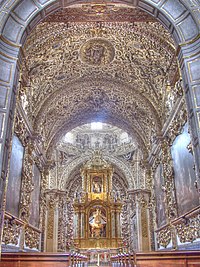
Back باروك إسباني جديد Arabic Barroco novohispano Spanish Architektura barokowa w Ameryce Łacińskiej Polish Barroco novo-hispano Portuguese Мексиканское барокко Russian Мексиканське бароко Ukrainian
This article needs additional citations for verification. (September 2014) |

New Spanish Baroque, also known as Mexican Baroque, refers to Baroque art in the Viceroyalty of New Spain. During this period, artists of New Spain experimented with expressive, contrasting, and realistic creative approaches, making art that became highly popular in New Spanish society.
Among notable artworks are polychrome sculptures, which as well as the technical skill they display, reflect the expressiveness and the colour contrasts characteristic of New Spanish Baroque.
Two styles can be traced in the architecture of New Spain: the Salomónico, developed from the mid-17th century, and the Estípite, which began in the early 18th century.
A model of the Cathedral of Puebla represents the architectural magnificence of New Spain. A choir book and a harpsichord of the 18th century highlight the importance of music for the colonial society of the Baroque period in Mexico.
- ^ Philadelphia Museum of Art (1908). Bulletin - Philadelphia Museum of Art. Philadelphia Museum of Art. Retrieved 9 February 2017.

